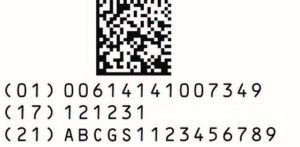Barcodes Comes to Healthcare …… Finally!
Category : Uncategorized
The move was prompted by the FDA [i]and coordinated with other governments regulators around the world.  The first clue the consumer will see is called the UDI (Universal Device Identifier). It will appear on several million healthcare items and can take various forms in barcode or even be in RFID (radio tags) as well.
The first clue the consumer will see is called the UDI (Universal Device Identifier). It will appear on several million healthcare items and can take various forms in barcode or even be in RFID (radio tags) as well.
Unlike our retail barcodes, which only have a product identification encoded, UDI’s  can contain a product ID as well as the specific batch number, serial number, expiration date, etc. for the package. All are important for safe use, tracking and to help in the event of a recall.
can contain a product ID as well as the specific batch number, serial number, expiration date, etc. for the package. All are important for safe use, tracking and to help in the event of a recall.
Compliance – Quality – Content
Those of us that use the self-checkout lane at the market know that some barcodes can be hard to scan or even un-scannable. These scanning problems are caused by out of spec barcodes. This is, of course unacceptable in healthcare[ii]. The UDI must be accurate and readable by all the various scanner types expected to be used. To make that happen, manufacturers are required by regulation to meet standards[iii] for print quality, size and content. Like other manufacturing quality characteristics, records are kept for review by internal and external QA personnel. Regulators around the world issue warning letters to manufacturers and many of those relate to the labels. Barcode and barcode quality is new and complex for many manufacturers. However, it is the binding technology between the physical and digital worlds we live in and vital that it be done right. It may be best to get some outside help.
Is 100% inspection required?
The answer to this question depends on a few things. The most frequently used printing technology for on demand variable barcode printing is called thermal transfer. When used correctly, this digital printing technology is up to the task. Other printing technologies may be somewhat trickier to use. Manufacturers will evaluate their current printing capability with SQC (Statistical Quality Control)[iv] to determine if it can be used without inspecting every label individually. In either case, Good Manufacturing Practices require that the printing process be used according to set procedures. [v]
So, the answer then is usually a qualified NO – 100% inspection is not usually required unless the printing technology is not capable or inconsistent or if you can’t follow procedures for dependable use.
In healthcare, barcodes can contain multiple fields of information. There are additional rules associated with how that data is formatted and its contents. That is an additional inspection that would be wise to perform since a barcode that is not formatted correctly is as bad as one that can’t be read at all.
Where Are We Now
Manufacturers have already started to mark their products. Hospitals are already starting to make plans for changing over to the UDI system. It will take a bit of time to build up the database (1.3 million as of 2/1/17) and the quality of marks and content and add the new processes at the hospitals. But this important change will bring a significant positive impact to our healthcare system for many years to come.
Contact us for more information.
[i] FDA Announcement and Objectives http://www.fda.gov/MedicalDevices/DeviceRegulationandGuidance/UniqueDeviceIdentification/
[ii] FDA Quality Systems http://www.fda.gov/MedicalDevices/DeviceRegulationandGuidance/PostmarketRequirements/QualitySystemsRegulations/ucm230127.htm
[iii] Excerpt from GS1 Specifications – a FDA UDI issuing authority
| Symbol(s) specified | (*) X-dimension mm (inches) | (**) Minimum symbol height for given X mm (inches) | Quiet Zone | Minimum quality specification | |||||
| Minimum | Target | Maximum | For
minimum Xdimension |
For target Xdimension | For maximum X-dimension | Left Right | |||
| GS1- 128 | 0.250
(0.00984″ ) |
0.495
(0.0195″) |
0.495
(0.0195″) |
12.70
(0.500″) |
12.70
(0.500″) |
12.70
(0.500″) |
10X | 10X | 1.5/06/660 |
| GS1
DataMatrix (ECC 200) (***) |
0.380
(0.0150″) |
0.380
(0.0150″) |
0.495
(0.0195″) |
Height is determined by X-dimension and data that is encoded | 1X on all four sides | 1.5/08/660 | |||
Note that minimum quality is shown as ISO grade/aperture/wavelength
[iv] Using verifiers to get SQC information – SCANALYST 3
[v] GMP – How to use thermal transfer printing correctly to comply with labeling requirements